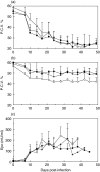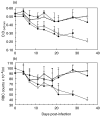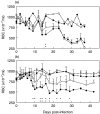TNF-alpha mediates the development of anaemia in a murine Trypanosoma brucei rhodesiense infection, but not the anaemia associated with a murine Trypanosoma congolense infection
- PMID: 15730385
- PMCID: PMC1809320
- DOI: 10.1111/j.1365-2249.2004.02717.x
TNF-alpha mediates the development of anaemia in a murine Trypanosoma brucei rhodesiense infection, but not the anaemia associated with a murine Trypanosoma congolense infection
Abstract
Development of anaemia in inflammatory diseases is cytokine-mediated. Specifically, the levels of tumour necrosis factor-alpha (TNF-alpha), produced by activated macrophages, are correlated with severity of disease and anaemia in infections and chronic disease. In African trypanosomiasis, anaemia develops very early in infection around the time when parasites become detectable in the blood. Since the anaemia persists after the first waves of parasitaemia when low numbers of trypanosomes are circulating in the blood, it is generally assumed that anaemia is not directly induced by a parasite factor, but might be cytokine-mediated, as in other cases of anaemia accompanying inflammation. To clarify the role of TNF-alpha in the development of anaemia, blood parameters of wild type (TNF-alpha+/+), TNF-alpha-null (TNF-alpha-/-) and TNF-alpha-hemizygous (TNF-alpha-/+) trypanotolerant mice were compared during infections with the cattle parasite Trypanosoma congolense. No differences in PCV, erythrocyte numbers or haemoglobin were observed between TNF-alpha-deficient and wild type mice, suggesting that the decrease in erythrocytes was not mediated by TNF-alpha. Erythropoetin (EPO) levels increased during infection and no significant differences in EPO levels were observed between the three mouse strains. In contrast, during an infection with the human pathogen Trypanosoma brucei rhodesiense, the number of red blood cells in TNF-alpha-deficient mice remained significantly higher than in the wild type mice. These data suggest that more than one mechanism promotes the development of anaemia associated with trypanosomiasis.
Figures



Similar articles
-
The secretion of acute phase proteins and inflammatory cytokines during Trypanosoma congolense infection is not affected by the absence of the TNF-alpha gene.Acta Trop. 2004 Sep;92(1):35-42. doi: 10.1016/j.actatropica.2004.05.013. Acta Trop. 2004. PMID: 15301973
-
Susceptibility of TNF-alpha-deficient mice to Trypanosoma congolense is not due to a defective antibody response.Acta Trop. 2004 Nov-Dec;92(3):193-203. doi: 10.1016/j.actatropica.2004.05.015. Acta Trop. 2004. PMID: 15533287
-
Tumor necrosis factor (TNF) receptor-1 (TNFp55) signal transduction and macrophage-derived soluble TNF are crucial for nitric oxide-mediated Trypanosoma congolense parasite killing.J Infect Dis. 2007 Sep 15;196(6):954-62. doi: 10.1086/520815. Epub 2007 Aug 10. J Infect Dis. 2007. PMID: 17703428
-
Role of cytokines in Trypanosoma brucei-induced anaemia: A review of the literature.Malawi Med J. 2015 Jun;27(2):45-50. doi: 10.4314/mmj.v27i2.3. Malawi Med J. 2015. PMID: 26405511 Free PMC article. Review.
-
Bovine trypanotolerance: A natural ability to prevent severe anaemia and haemophagocytic syndrome?Int J Parasitol. 2006 May 1;36(5):521-8. doi: 10.1016/j.ijpara.2006.02.012. Epub 2006 Mar 13. Int J Parasitol. 2006. PMID: 16678182 Review.
Cited by
-
Host Immune Responses and Immune Evasion Strategies in African Trypanosomiasis.Front Immunol. 2019 Nov 22;10:2738. doi: 10.3389/fimmu.2019.02738. eCollection 2019. Front Immunol. 2019. PMID: 31824512 Free PMC article. Review.
-
Differential virulence of Trypanosoma brucei rhodesiense isolates does not influence the outcome of treatment with anti-trypanosomal drugs in the mouse model.PLoS One. 2020 Nov 5;15(11):e0229060. doi: 10.1371/journal.pone.0229060. eCollection 2020. PLoS One. 2020. PMID: 33151938 Free PMC article.
-
A Preliminary Study on the Relationship between Parasitaemia and Cytokine Expression of Peripheral Blood Cells in Trypanosoma vivax-Experimentally Infected Cattle.Animals (Basel). 2021 Nov 8;11(11):3191. doi: 10.3390/ani11113191. Animals (Basel). 2021. PMID: 34827923 Free PMC article.
-
Mechanisms controlling anaemia in Trypanosoma congolense infected mice.PLoS One. 2009;4(4):e5170. doi: 10.1371/journal.pone.0005170. Epub 2009 Apr 13. PLoS One. 2009. PMID: 19365556 Free PMC article.
-
Anaemia Associated with Trypanosomes Infections in Cattle of West Gojjam Zone, Northwest Ethiopia.Vet Med Int. 2021 Jun 29;2021:5531537. doi: 10.1155/2021/5531537. eCollection 2021. Vet Med Int. 2021. PMID: 34306606 Free PMC article.
References
-
- Jenkins GC, Facer CA. Hematology of African trypanosomiasis. In: Tizard I, editor. Immunology and Pathogenesis of Trypanosomes. Boca Raton: CRC Press Inc.; 1985. pp. 13–44.
-
- Trail JCM, d’Ieteren GDM, Feron A, Kakiese O, Mulungo M, Pelo M. Effect of trypanosome infection, control of parasitaemia and control of anaemia development on productivity of N’Dama cattle. Acta Trop. 1991;48:37–45. - PubMed
-
- Naessens J, Leak SGA, Kennedy DJ, Kemp S, Teale SJ. Responses of hemopoietic chimaera twin cattle from susceptible and tolerant genetic backgrounds to experimental infection with Trypanosoma congolense. Vet Parasitol. 2003;111:125–42. - PubMed
-
- Murray M, Dexter TM. Anaemia in bovine African trypanosomiasis. Acta Trop. 1988;45:389–432. - PubMed
-
- Andrianarivo AG, Muiya P, Opollo M, Logan-Henfrey LL. Trypanosoma congolense. comparative effects of a primary infection on bone marrow progenitor cells from N’Dama and Boran cattle. Exp Parasitol. 1995;80:407–18. - PubMed
Publication types
MeSH terms
Substances
LinkOut - more resources
Full Text Sources
Medical
Molecular Biology Databases
Research Materials

